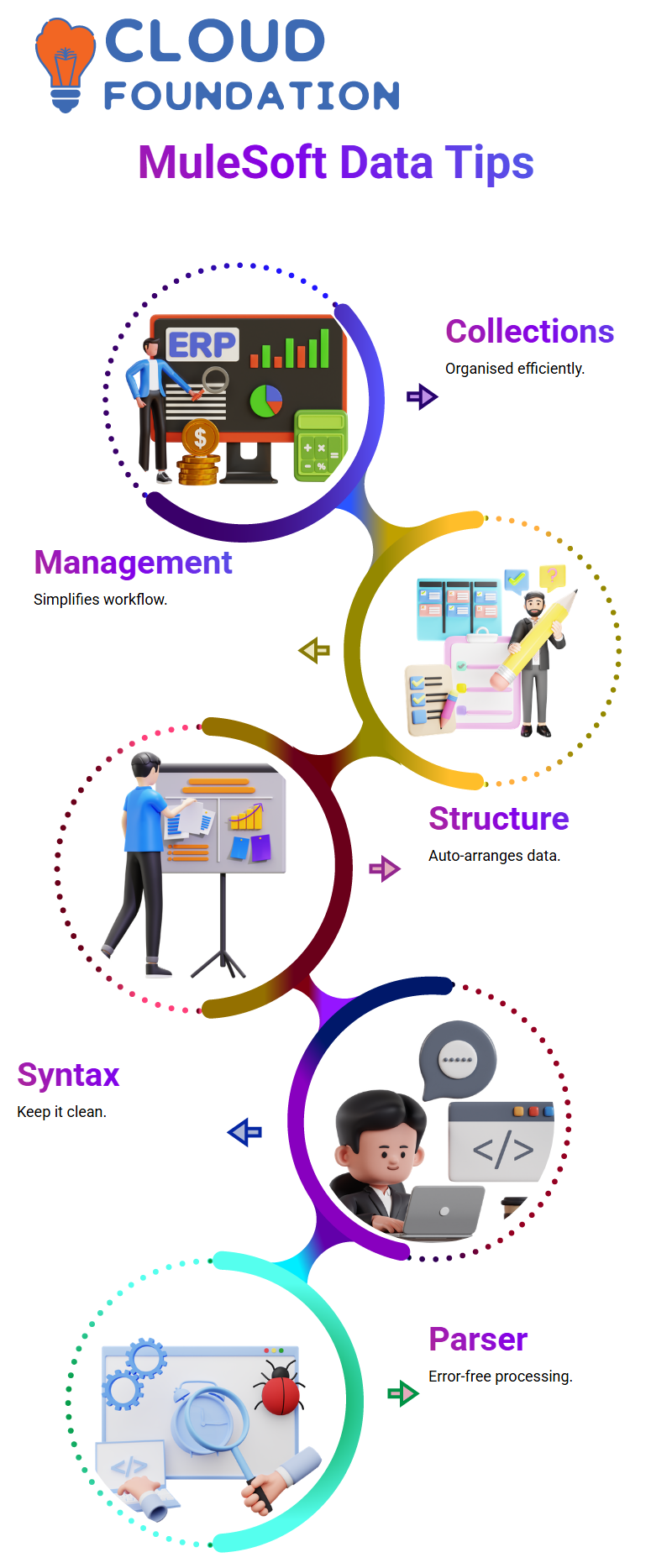How to Access the Data in MuleSoft?
Data Levels in MuleSoft
The fact that MuleSoft can control first-level IDS, second-level IDS, and so on is beyond anyone’s expectations.
It proposes to us the ability to control data in a highly productive manner, paying attention to specific features, such as IDS, and the connections between them that exist at various levels.
A representation that still sticks with me is that of MuleSoft, which has given us the power not only to get but also to compute the exact IDS from different levels. In cases where both fetching at the first level and going inside the second are required, MuleSoft is the most reliable and easiest of all the tools.

Data Structures in MuleSoft
When you are at the point of a MuleSoft project, then your knowledge of the available types of data becomes the most requisite thing in the project. Regardless of your level of expertise, MuleSoft offers excellent tools for management.
MuleSoft, which enables quicker data access, will thus solve this organisational problem. In the first case, the id is on the top level, while in the second one, the second level is surrounded by the first one. This organisation of data is of great help in maintaining the structure’s transparency.
Descendant selection in MuleSoft is a crucial element in identifying objects at multiple levels. In line with the analogy of a family tree, where each new generation is interrelated with the previous one, MuleSoft adopts a similar hierarchical pattern.
MuleSoft is highly flexible, as it can extract not only one value but multiple values. This aspect cannot be overstated when dealing with complex datasets that comprise multiple hierarchical structures.
Data Process in MuleSoft
Going through the various levels will no longer require much effort if you utilise MuleSoft to direct data. The method of combining descendant filtering with multi-value filtering effectively extracts the indispensable data.
Businesses can automate data processing by integrating MuleSoft into their workflows. This action not only reduces human intervention but also enhances the operational capability.
MuleSoft continues to respond to new mandates and is now being presented as a more viable alternative for structuring data. Believing in its possibility, when we look into the future, it is the mighty tools to be used that will give an entirely different slant to the management of our knowledge.

Data Access with MuleSoft variables
MuleSoft is easier with variables; they will make all the difference in business. For example, think of a situation where you want to conduct a large number of levels of data. With an isolated line of code to make a variable, you can now extract and save additional payload sections.
Suppose you would like to extract the second level of data. The quickest way is to generate a variable ‘second’ and assign to it the value of the second level in the payload, thereby straightforwardly receiving the reference point. This will authorise MuleSoft to operate with the variable and consequently rationalise your sequence directly.
Payload Manipulation in MuleSoft
MuleSoft not only allows the simple use of variables, but also lets you inspect the pioneering ones.
Are you in the right workplace that accommodates a wide range of data terrains? There’s no stopping you! You can employ a combination of variables and MuleSoft to deal with intricate multi-value zones in the blink of an eye.
For demonstration, if you have a payload structure that is three levels deep, you are at liberty to create variables, each of which is a reference to what you need, and also allows you to manipulate data.
Constant and Function in MuleSoft
Function definitional programming is used in MuleSoft to contribute to the competent data flow. A constant function is a function that is used to assign values to the variables more quickly.
Although most variables reside in the head, there can be situations when the body assumes the responsibilities of the assignments.

For example, when you work on a batch of IDS and want to line them up, you will have to use the variables. MuleSoft offers an additional feature that enables structured storage, making it suitable for payload transformations where the data remains in a structured format.
Large Data Sets in MuleSoft
In MuleSoft, data can be handled skillfully, from tasks such as managing multiple payloads to more complex operations that ensure smooth data transformation with the platform’s assistance.
One way to manage organised insight is through the use of logical location identifiers. With the help of MuleSoft’s wide-ranging performance, developers can carry out optimisations on inquiries and condition checks, ensuring that variable assignments are carried out without issues even in very deeply nested processes.

Data Mapping in MuleSoft
When dealing with payload values, MuleSoft ensures that calculations are carried out before the execution process begins. That being said, your price and action variables will be mapped correctly.
System developers using MuleSoft can process variables systematically, ensuring that data integrity is maintained while the system remains operational.
Command Data with MuleSoft
Whenever I get into the world of what MuleSoft can do for data controlling, I am always surprised at how easy it becomes.
Let me show you by providing another representation, at the second or third level. Do you need to obtain the IDS? MuleSoft sanctions such things as ‘payload dot dot ID’ to be the ones to access
The key to MuleSoft is that it can be tailored to meet the specific needs of the end-user. To be more unambiguous, it doesn’t mind if you have to retrieve the data from one level or multiple levels—MuleSoft guarantees the right choice.
MuleSoft’s Data Recovery
MuleSoft’s pioneering features are the reason the application is your go-to choice for data retrieval. Once these tools are utilised, tasks such as multi-level and multi-value identification can be completed with a single click.

While the “dot ID” of MuleSoft is helping the first and third levels, it also makes the entire data retrieval process easier and more accurate.
What strikes me the most about MuleSoft is its persistence. You are not just doing things right; you are taking your job a step forward. That is, the miners handled the technical details of the services, and as a result, your work became even more productive than it was before.
Data Modelling with MuleSoft
The primary action to take when working with MuleSoft capably is to compare it with the old data model. In other words, MuleSoft will advise you to the identification and organisation of the vital elements of the data, regardless of whether you are dealing with a student, an employee or occurrence evidence.
As a prototype, student data may contain exceptional information such as IDS, names, classes, and grades, whereas employee data can include IDS, names, and tasks.
By applying MuleSoft, it is possible to organise the data so well that it can be easily found and modified.
Backend Integration with MuleSoft
In addition to keeping the data well-organised, MuleSoft also expedites the insertion of background databases, thus enabling the uninterrupted flow of evidence. By understanding how data is implemented, you can easily meet the school’s API development needs with MuleSoft.
Extended educational institutions could find it helpful to have APIS that cover every part of school administration, such as student registration and event management. This could be made possible with MuleSoft being a dependable and functional catalyst for such systems.
API Development in MuleSoft
With MuleSoft, developers can now make API workflows more productive by deploying fragments, data types, and resources in a structured manner. MuleSoft speeds up the API efficacy.
The adoption of MuleSoft’s best practices results in API development that can be scaled and managed with ease. MuleSoft, as always, is the one that has been setting the standard for API schemes and their realisation.
Data Storage in MuleSoft
Through MuleSoft, object models are not only designed to fit the backend database structure but are also consistent with it. The details are finally stored in the database, capitalising on MuleSoft’s power of field types and properties that are spot-on, thereby confirming its prowess in data storage.
For prototypes, MuleSoft offers developers the opportunity to determine which domains are optional or mandatory, thereby contributing to the flexibility of the data being processed.
Syntax Tips for MuleSoft Developers
Now I will tell you something, little as it may be, about syntax, while you are at MuleSoft. If you are describing a structure, then, as is known, a unit of space, even without a colon, can influence the result. MuleSoft’s parser is strict and error-free; thus, keep your syntax clean.

Most of the skills I gained were through practical application, and it was a real lifesaver.
MuleSoft’s Flow Architecture
The most important thing you need to grasp about MuleSoft is its flow architecture The system is the central concept in MuleSoft A flow is a unit that gets inputs from multiple channels, processes the data and then routes the results to the suitable location Imagine it as the circulatory system of MuleSoft, which paces the very data movement proficiently.

MuleSoft’s Role in Data Storage
Let’s get practical with this representation: Think about transmitting data from Postman with the help of MuleSoft and then saving it in any database. MuleSoft essentially automates these steps in its workflow, from inputting data to administering it and keeping it in a table.
MuleSoft Inbound and Outbound Components
We should start by discussing how MuleSoft manages two-way communication. These are the front-end components and back-end components. The former, such as HTTP listeners, tolerate messages to be received from remote systems. In the latter, the processed data is sent to HTTP servers, databases, and other systems. Outbound components, for example, are pushing data that has already been processed to systems such as HTTP servers or databases.
Thus, if an HTTP listener is the representation, it receives requests from the network that are then sent for processing.
MuleSoft orchestrates the process by first converting the message to a database-suited format and then inserting it into the target database. The flow is completed by providing a response or acknowledgement to the customer.

Navya Chandrika
Author




